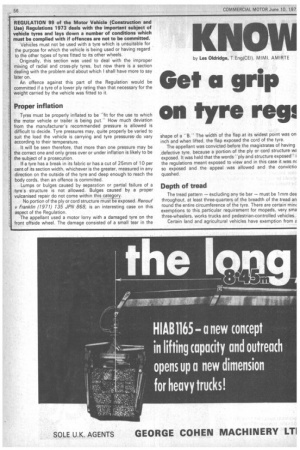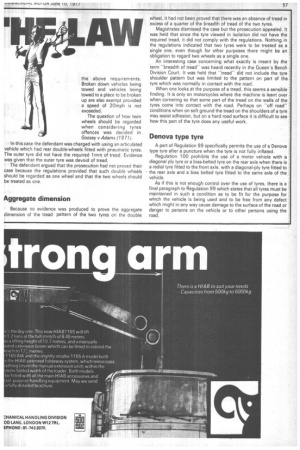NO1111
Page 58

Page 59

If you've noticed an error in this article please click here to report it so we can fix it.
by Les Oldridge, T.Eng(CEI), MIMI, AMIRTE
Gets grip on tyre regm
REGULATION 99 of the Motor Vehicle (Construction and Use) Regulations 1973 deals with the important subject of vehicle tyres and lays down a number of conditions which must be complied with if offences are not to be committed.
Vehicles must not be used with a tyre which is unsuitable for the purpose for which the vehicle is being used or having regard to the other types of tyres fitted to its other wheels.
Originally, this section was used to deal with the improper mixing of radial and cross-ply tyres, but now there is a section dealing with the problem and about which I shall have more to say later on.
An offence against this part of the Regulation would be committed if a tyre of a lower ply rating than that necessary for the weight carried by the vehicle was fitted to it.
Proper inflation
Tyres must be properly inflated to be "fit for the use to which the motor vehicle or trailer is being put.How much deviation from the manufacturer's recommended pressure is allowed is difficult to decide_ Tyre pressures may, quite properly be varied to suit the load the vehicle is carrying and tyre pressures, do vary according to their temperature.
It will be seen therefore, that more than one pressure may be the correct one and only gross over or under inflation is likely to be the subject of a prosecution.
If a tyre has a break in its fabric or has a cut of 25mm of 10 per cent of its section width, whichever is the greater, measured in any direction on the outside of the tyre and deep enough to reach the body cords, then an offence is committed.
Lumps or bulges caused by separation or partial failure of a tyre's structure is not allowed. Bulges caused by a proper vulcanised repair do not come within this category.
No portion of the ply or cord structure must be exposed. Renouf v Franklin (1971) 135 JPN 868, is an interesting case on this aspect of the Regulation.
The appellant used a motor lorry with a damaged tyre on the front offside wheel. The damage consisted of a small tear in the
shape of a "B.The width of the flap at its widest point was on inch and when lifted, the flap exposed the cord of the tyre.
The appellant was convicted before the magistrates of having .defective tyre, because a portion of the ply or cord structure wE exposed. It was held that the words -ply and structure exposedi the regulations meant exposed to view and in this case it was ric so exposed and the appeal was allowed and the convictio quashed.
Depth of tread
The tread pattern — excluding any tie bar — must be 1 mm doe throughout, at least three-quarters of the breadth of the tread an round the entire circumference of the tyre. There are certain mint exemptions to this particular requirement for mopeds, very sma three-wheelers, works trucks and pedestrian-controlled vehicles.
Certain land and agricultural vehicles have exemption from a the above requirements. Broken clown vehicles being towed and vehicles being towed to a place to be broken up are also exempt provided a speed of 20mph is not exceeded.
The question of how twin wheels should be regarded when considering tyres offences was decided in Goosey v Adams (1 97 1).
In this case the defendant was charged with using an articulated vehicle which had rear double-wheels fitted with pneumatic tyres. The outer tyre did not have the required 1mrri of tread. Evidence was given that the outer tyre was devoid of tread.
The defendant argued that the prosecution had not proved their case because the regulations provided that such double wheels should be regarded as one wheel and that the two wheels should be treated as one.
Aggregate dimension
Because no evidence was produced to prove the aggregate dimension of the tread pattern of the two tyres on the double wheel, it had not been proved that there was an absence of tread in excess of a quarter of the breadth of tread of the two tyres.
Magistrates dismissed the case but the prosecution appealed. It was held that since the tyre viewed in isolation did not have the . required tread, it did not comply with the regulations. Nothing in the regulations indicated that two tyres were to be treated as a single one, even though for other purposes there might be an obligation to regard two wheels as a single one.
An interesting case concerning what exactly is meant by the term "breadth of tread" was heard recently in the Queen's Bench Division Court. It was held that "tread" did not include the tyre shoulder pattern but was limited to the pattern on part of the tyre which was normally in contact with the road.
When one looks at the purpose of a tread, this seems a sensible finding. It is only on motorcycles where the machine is leant over when cornering so that some part of the tread on the walls of the tyres come into contact with the road. Perhaps on "off road" conditions when on soft ground the tread on the shoulders of a tyre may assist adhesion, but on a hard road surface it is difficult to see how this part of the tyre does any useful work.
Denova type tyre
A part of Regulation 99 specifically permits the use of a Denova type tyre after a puncture when the tyre is not fully inflated.
Regulation 100 prohibits the use of a motor vehicle with a diagonal ply tyre or a bias-belted tyre on the rear axle when there is a radial tyre fitted to the front axle, with a diagonal-ply tyre fitted to the rear axle and a bias belted tyre fitted to the same axle of the vehicle.
As if this is not enough control over the use of tyres, there is a final paragraph to Regulation 99 which states.that all tyres must be maintained in such a condition as to be fit for the purpose for which the vehicle is being used and to be free from any defect which might in any way cause damage to the surface of the road or danger to persons on the vehicle or to other persons using the road,




























































































